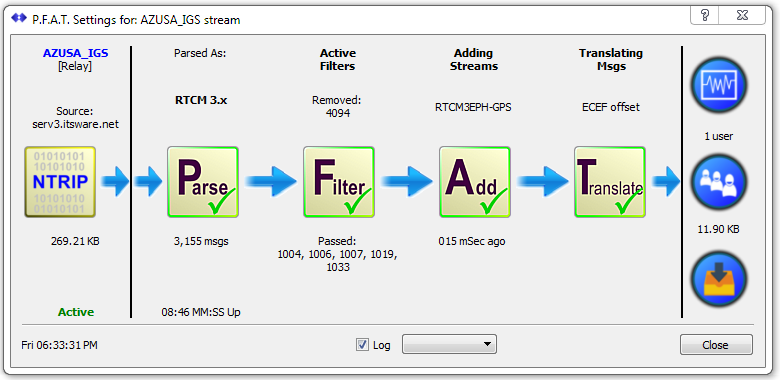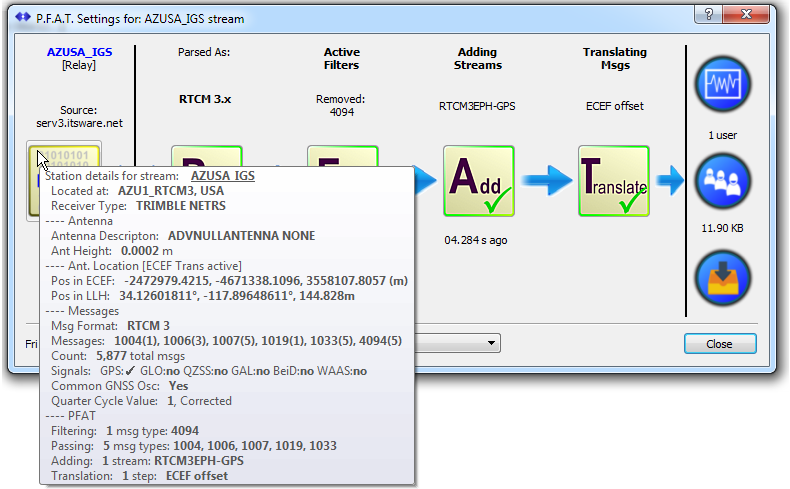The most common use of the PFAT™ ability is to modify the source NTRIP Caster data stream from a single Base Station for use, and place the resulting stream out on the SNIP Caster.
A typical PFAT use
A typical example of that is shown below where the PFAT setting have been set to operate on the stream AZU1_RTCM:
- Remove message 4094 (it is not used)
- Add additional orbital data for GPS GNSS types (message type 1019)
- Adjust the ECEF Message Type from 1005 to be 1006 to a common value (in this case IGS08 at EPOCH:2018.1055) with a corrected antenna height offset.
The resulting stream is being served out under the assigned vanity name (“AZUSA_IGS“) The vanity name was set up using the Add New Caster Stream dialog (under the Remote tab).
The resulting stream is better suited to local needs and is used in a NEAR mountPt where all the stations follow the same IGS08 reference frame.
Hint: The PFAT View Setting Dialog (shown above and below) provides a good summary of the stream processing flow. Holding your mouse over the various icons provides additional useful data, such as station details as shown below. Clicking on the button icons will also bring up the dialog window for that section of PFAT, or you may select them with the right click dialog for each stream.
Some Local Trivia: The Californian town AZUSA (“ah-zoo-sah”) gets it name from an Gabrieliño Indian phrase used to refer to the San Gabriel Valley and the San Gabriel River. It was also used by the early city fathers to mean “Azusa stands for everything from A to Z in the U.S.A.” It does not appear to have ever been used in that way by Henry Dalton, owner of the original Rancho (an 1844 land grant) on which the town lies. The AZUSA Base Station is located on the grounds of his original home, now a local high school.
Sending Multiple Streams from the same source
If there was a need to send another variation of this stream from the same Caster, perhaps in its original form (or some other combination of forms), one can proceed in two ways.
- One can reconnect to the source stream a 2nd time (if it is over TCP/IP and not serial).
- One can reconnect to it directly from within SNIP, simply by connecting to the SNIP Caster IP and Port.
The second of these is to be preferred because it does not create additional network traffic to send the same data to the SNIP node twice.
In general, and in the Lite models of SNIP, connecting to yourself is not allowed and is detected by SNIP. This check is done regardless of the IP or URL used. If self-connection is detected, you will receive a single warning, as shown below, and then the stream will be disabled.
[AZU1_RTCM3]: NOTE: The Stream AZU1_RTCM3 at xxx.itsware.net:2101 [Slot R005] just connected to THIS machine, that's redundant. [AZU1_RTCM3]: This slot has been disabled, and will not attempt to reconnect. [AZU1_RTCM3]: There is no reason to do this, as you already have access to this stream. [AZU1_RTCM3]: NOTE:
With the advent of PFAT in SNIP, connection to yourself (in order to obtain a 2nd copy of the stream for further PFAT uses) is allowed. You are provided a informational dialog to confirm this action, and if accepted can then connect. SNIP will optimize the connection internally, but otherwise the stream is treated like any other. This method also works with streams originating from local serial ports.
The most common use case of this is with the the combined RTCM3EPH orbital data stream, which is often broken out into a different data stream for each GNSS orbital message type by using the PFAT Filter method to remove unwanted message content.


